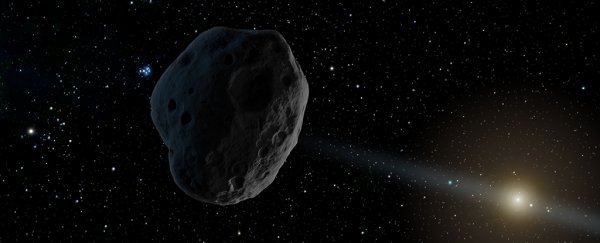Former Microsoft executive, entrepreneur, and physics PhD Nathan Myhrvold is making some big claims: a lot of the data NASA has on distant asteroids is wrong. And those errors are standing in the way of serious asteroid science.
Myhrvold's claims first gained prominence a couple of years ago, but he is now back in the spotlight after his work was finally published in a respected, peer-reviewed journal – which means scientists are now taking a serious look at it again.
Up until now the official NASA line has been to stick with its original data, but the newly published study could force a rethink – and ultimately change our perspective on what's happening out in the Solar System.
The data in question has been gathered by NASA's NEOWISE (Near-Earth Object Wide-field Infrared Survey Explorer) mission. Since 2011, the telescope has documented the presence of some 158,000 space rocks.
"Asteroids are very important," Myhrvold told Zoë Corbyn at the Observer. "They tell us a lot about the origin of the Solar System. The work of hundreds of scientists has been based on this NEOWISE data."
Myhrvold has written a lengthy blog post about his objections to how NASA scientists have interpreted the readings from NEOWISE, but it boils down to the statistical models and methods used.
Part of the problem is a lack of consistency, Myhrvold says – readings from NEOWISE have been mixed with older data, and while that older data might be more accurate, it destabilises the model as a whole.
What's more, NASA's team has failed to properly account for Kirchhoff's law of thermal radiation in how asteroids emit heat, according to Myhrvold. This is crucial in interpreting the readings NEOWISE is getting.
Other errors and bad modelling practices are mentioned by Myhrvold, among more serious allegations that NASA scientists may have deliberately tried to cover their tracks and fudge the results they've been getting.
The bottom line, Myhrvold says, is that the NEOWISE data a lot of researchers now rely on has a much bigger margin of error than previously thought. So he believes that we can't really trust it, particularly when it comes to how big these space rocks actually are.
"What I think happened is they made some poor choices of statistical methods," Myhrvold told the Observer. "Then, to cover that up, they didn't publish a lot of the information that would help someone else replicate it. I'm afraid they have both over and underestimated."
For its part, NASA has yet to respond to the newly published papers, though earlier this month an official statement said the team was standing by its previous work – which has also been peer-reviewed and published.
Other scientists have been weighing in, too. One of the most recently published papers found NASA's NEOWISE data held up under scrutiny, though the study only concentrated on a small fraction of those 158,000 objects.
"In my opinion, [Myhrvold's paper] has important things to say," Alan Harris from the MoreData! consulting firm in California told Alexandra Witze at Nature. He was one of the reviewers of the paper.
"It is my hope that the scientific community will read the paper and pay attention to the analysis Myhrvold has presented, as he has raised a number of significant issues."
As more researchers take a look at the data, and more powerful telescopes are swung towards the stars, we should eventually get to the bottom of who is in the right here.
Part of the debate involves funding for a proposed NEOCam or Near-Earth Object Camera, which NASA wants to use to further refine its results. If it gets the go ahead, it should give us more information to work with – but only if scientists can agree on the right way that the data it collects gets analysed.
The more data we have – and the more accurate we can make it – the better we can protect against the slim chance of an asteroid colliding with Earth, and the greater understanding we gain about the Universe and how it's evolving.
"The net result is that we'll gradually learn more about the asteroid population," one of the reviewers of the new paper, planetary scientist Will Grundy from Lowell Observatory in Arizona, told Nature.
"And if eventually a threatening asteroid is discovered, we'll be able to know more about it because of techniques honed in studies like this."
While the arguments have become quite heated, we're hoping that ultimately this ends up in more accurate data and better asteroid models. After all, that's what everyone's after.
Myhrvold's latest paper has been published in Icarus.
